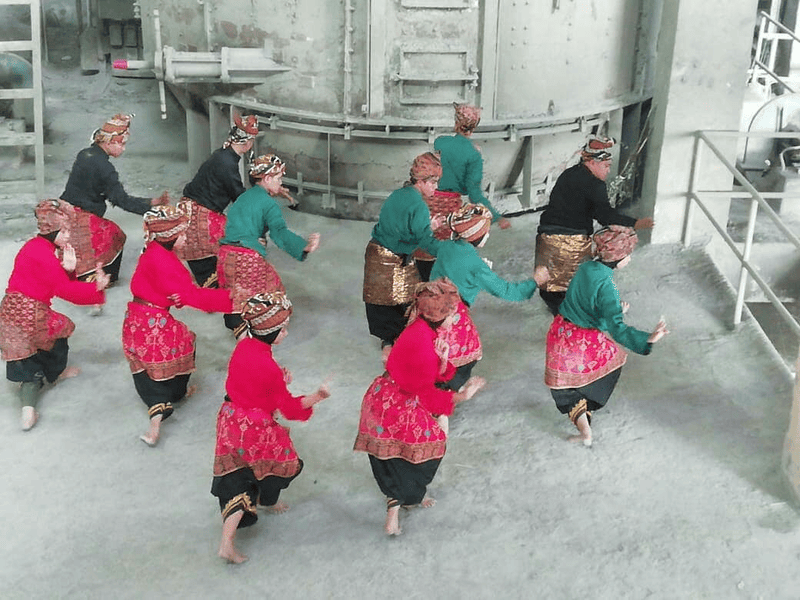Throughout a Randai performance, participants engage in highly dynamic movements that frequently demand considerable physical exertion, testifying to its athletic rigour.
The Minangkabau region, often referred to as the Minang realm, possesses a multifaceted appeal that extends far beyond its globally recognised culinary traditions. While Minang cuisine, celebrated for its rich flavours and unique preparation methods, certainly draws a considerable number of visitors, the area’s tourism sector is equally bolstered by a vibrant array of cultural offerings. What truly distinguishes the Minang landscape, however, is the enduring preservation of its deep-rooted cultural traditions. In an era increasingly shaped by globalising influences, Minang society has remarkably succeeded in maintaining these ancestral customs, even to the extent of transforming many of them into captivating tourist attractions that offer unique insights into the local way of life.
A diverse collection of these prominent traditions showcases the ingenuity and spirit of the Minang people. These include dynamic animal-centric competitions such as Pacu Itiak, the spirited duck race; Pacu Jawi, the exhilarating bull race; and Pacu Anjing, a competitive dog race. Beyond these, traditional activities like Baburu, which encompasses various hunting practices, and Selaju Sampan, the thrilling boat racing, also feature prominently, alongside numerous other distinctive cultural expressions. Among these rich traditions, Randai stands out as a unique communal performance. This traditional Minangkabau art form is characterised by its circular formation, where participants fluidly move while sequentially narrating stories through melodic songs, creating an immersive and engaging theatrical experience.
The beautiful game
The Minangkabau region is, furthermore, home to a wealth of traditional anak nagari (village children’s) games. These historical forms of play are not merely recreational activities but represent a profound aspect of folk art. Many of these traditional games have evolved into competitive events or even serve as the centrepiece of art festivals, demonstrating their significance beyond being a simple pastime. Within Minangkabau, the proliferation of these folk games for anak nagari symbolises a proactive commitment to the protection, development, utilisation, and fostering of cultural heritage. They are vital components in the broader advancement of the region’s unique cultural objects and serve to continually enrich its traditional culture, ensuring its vibrancy for future generations.
These traditional games, beyond their cultural and artistic value, offer tangible benefits for the children who engage in them. They are instrumental in cultivating essential character traits such as honesty and fostering a strong sense of camaraderie among participants. Moreover, these games play a crucial role in instilling and refining high levels of sportsmanship, as well as promoting effective teamwork. The deliberate preservation of these cultural practices, actively maintained and performed by the anak nagari, acts as a significant catalyst for the progression of the local tourism sector. By presenting these rich cultural performances in various forms, the region enhances its appeal, offering authentic and immersive experiences that attract visitors seeking more than just scenic beauty or culinary delights.
Heart of champions
A particularly compelling example of a Minang tradition that blurs the lines between art, culture, and physical endeavour is Randai. While it may not strictly align with standard definitions of sports such as football or swimming, its performances are undeniably infused with robust physical elements. These components position Randai closer to the realm of martial arts and dynamic dance movements. Throughout a Randai performance, participants engage in highly dynamic movements that frequently demand considerable physical exertion, testifying to its athletic rigour.
Several key aspects further underscore why Randai, in a broader analytical context, can genuinely be regarded as a “Minang sport.” Firstly, its potent physical elements are undeniable. Randai expertly integrates diverse artistic disciplines—dance, drama, and music—with intrinsic elements of Minang martial arts. The movements central to Randai, particularly the distinctive Galombang (circular movements), are highly demanding, necessitating a high degree of strength, flexibility, and refined bodily coordination from its performers.
Secondly, achieving proficiency in a Randai performance requires dedicated and rigorous training, along with a significant level of expertise. This comprehensive training regimen extends beyond mere artistic memorisation, encompassing intensive physical aspects such as movement drills, strength building, and flexibility exercises. Concurrently, performers hone their artistic skills, including nuanced singing, expressive dialogue delivery, and compelling role-playing, all contributing to a holistic and physically demanding art form.
Thirdly, the crucial importance of peak physical conditioning for Randai performers cannot be overstated. A single Randai performance can be exceptionally long, often extending for up to five hours or even more. Such prolonged physical engagement mandates nothing less than exceptional stamina and robust physical fitness from the panggoreh (the Randai performers) to ensure they can maintain their energy and performance quality throughout the entire duration.
Fourthly, the inherent sporting elements within Randai‘s movements are evident. Many of the core movements in Randai, most notably the Galombang, bear a striking resemblance to techniques found in traditional Minang martial arts, such as Pencak Silat. These specific movements inherently require attributes like strength, rapid execution (speed), and excellent bodily flexibility—all of which are fundamental and critical components recognised across various sporting disciplines.
Finally, reinforcing the previous points, the continuous practice and high level of proficiency required for executing Randai movements effectively further categorise it as a demanding physical discipline. This ongoing training is not merely about artistic refinement but fundamentally involves rigorous physical conditioning to enhance movement, build strength, and improve overall flexibility. These physical requirements are as crucial as the artistic elements of singing and dialogue.
Physical arts
Randai transcends its identity as a mere performing art; it can be broadly considered a “Minang sport” because it intrinsically incorporates potent physical elements, mandates rigorous and continuous training to develop high levels of expertise, and features dynamic movements that frequently demand substantial physical prowess.
Ultimately, Randai‘s unique blend of cultural expression and athletic rigour offers a compelling argument for its inclusion within a broader definition of sporting activity.
The writer, Donny Syofyan, is a lecturer at the Faculty of Humanities, Andalas University. All images are courtesy of Donny Syofyan.




